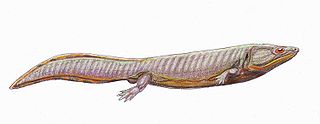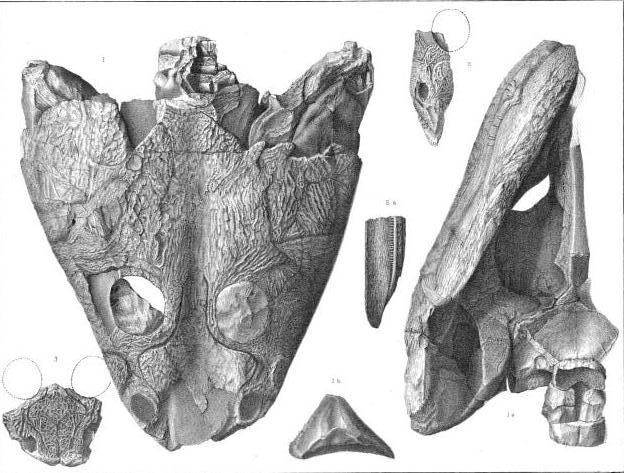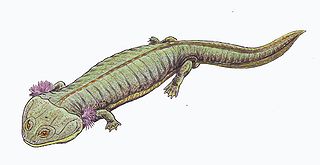
Wikipedia, GNU Free Documentation/Creative Commons Attribution.
| Temnospondyli | ||
| The Vertebrates | Dvinosauria |
| Vertebrates Home | Vertebrate | Vertebrate |
|
Abbreviated Dendrogram
Tetrapoda
├─┬─Lepospondyli
│ └─Reptiliomorpha
│
└─Temnospondyli
└─┬─Edopoidea
│ ├─Edops
│ └─Cochleosauridae
└─┬─┬─Dendrerpeton
│ └─┬─Eugryinus
│ └?─Dvinosauria (Ruta et al 2007, etc)
│ ├─┬─Trimerorhachidae
│ │ └?─Dvinosaurus ( Holmes 2000)
│ └─┬─Perryella
│ └─┬─Isodectes
│ └─┬?─Dvinosaurus
│ └─┬─Kourerpeton
│ └─Tupilakosauridae
│ └─Slaugenhopia
│ └─Tupilakosaurus
└─┬─Euskelia
│ ╞═Dissorophoidea
│ │ └─Lissamphibia
│ └─Eryopoidea
└─┬?─Dvinosauria (Yates &Warren 2000)
└─Stereospondyli
├─Rhinesuchidae
└─┬─Lydekkerinidae
├─┬─Plagiosauroidea
│ └─┬─Rhytidosteidae
│ └─Brachyopoidea
└─┬─Capitosauria
└─Trematosauria
├─Trematosauroidea
└─Metoposauroidea
|
Contents
Index |
 |
| Dvinosaurus egregius, life reconstruction by Dmitry Bogdanov. Wikipedia, GNU Free Documentation/Creative Commons Attribution. |
The Dvinosaurs are an assemblage of primitive, aquatic, mostly eel-like temnospondyls. They appear in the late Carboniferous but are most common in the Permian and earliest Triassic. Their exact relationship on the temnospondly family tree is uncertain, and their unfortunate fate has been to be a ping pong ball on successive cladograms. It all began when Milner 1990, in an early study of the group, gaves them a basal placement, just above Dendrerpetontidae and the Edopoids (two of of the most primitive Temnosopndyl groups) and basal to all other temnosondyls. Holmes 2000 assigned them a similar position. Yates and Warren 2000, in their groundbreaking cladistic review of the temnospondyls, place them crownward as one of the two main clades of Limnarchia, the other being the Stereospondylomorpha. Ruta and Bolt 2006 move them back to the stem, this time as the sister clade of the Dissorophoidea ) Ruta et al 2003b and Ruta et al 2007 in their supertree analyses likewise place them near the bottom of the tree, near Dendrerpeton, while the Dissorophoids are rescued from their primitive assignment and made the sister clade of the Eryopoidea, in agreement with Yates and Warren. Pawley 2006 chapter 5 pp.155f. has a similar placement, the dvinosaurs as basal but above the Cochleosaurs, and with Dendrerpetontidae included in a paraphyletic Edopoidea. But the dvinosaurs didn't languish as troglodytes for long because Englehorn et al. 2008 returned them to the base of the Limnarchia.
Clearly, the problem here is a combination of primitive and advanced characteristics that make the placement of these animals difficult, despite the fact that forms such as Trimerorhachis have been well known for over a century. If the Dvinosaurs are primitive, then the Middle Carboniferous Eugryinus (Carroll 2009, p.169, 172) could represent a transitional form between Dendrerpetontids and higher dvinosaurs MAK111114
Trimerorhachis is the best known of dvinosaurs. The following material by Smokeybjb (from Wikipedia) illustrates some details of what we know of this creature. Of lot of this would also apply to other dvinosaurs as well. MAK111114
Trimerorhachis is an extinct genus of dvinosaurian temnospondyl within the family Trimerorhachidae. It is known from the Early Permian of Texas. Its fossils are very common in the north-central part of the state. The type species of Trimerorhachis, T. insignis, was named by American paleontologist Edward Drinker Cope in 1878. A second species, T. sandovalensis, was named from New Mexico in 1980.
The length of the largest specimens of Trimerorhachis is estimated to have been almost a metre in length. Trimerorhachis has a large triangular head with upward-facing eyes positioned near the front of the skull. The trunk is long and the limbs are relatively short. The presence of a branchial apparatus indicates that Trimerorhachis had external gills in life, much like the modern axolotl (Case 1935). The body of Trimerorhachis is also completely covered by small and very thin osteoderms, which overlap and can be up to 20 layers thick. These osteoderms act as an armor-like covering, especially around the tail. Their weight may have helped Trimerorhachis sink to the bottom of lakes and rivers where it would feed (Olson 1979).
 |
| Edward Drinker Cope's illustration of fossils of Trimerorhachis insignis. Wikipedia - Public Domain |
Trimerorhachis was first described by Edward Drinker Cope in 1878. Specimens are often preserved as masses of bones that are mixed together and densely packed in slabs of rock (Williston 1915). Fossils are rarely found in articulation, although a slab of rock has been found with sixteen skulls and their associated vertebrae in an intact position (Case 1935). Most of these fossils preserve skulls and dorsal vertebrae, but rarely any other bones. Paleontologist S.W. Williston of the University of Chicago commented in 1915 that "it will only be by the fortunate discovery of a connected skeleton that the tail, ribs, and feet will be made known." (Williston 1915). A nearly complete specimen was discovered the following year near Seymour, Texas, and Williston was able to describe the entire postcranial skeleton of Trimerorhachis (Williston 1916)
In 1955, paleontologist Edwin Harris Colbert described the scales of Trimerorhachis. He noted that they were oval-shaped and overlapping and that each had a base layer of longitudinal striations covered by another layer ring-like ridges, the growth rings of the scales. The scales were more similar to fish scales than they were to reptile scales (Colbert 1955). In 1979, paleontologist Everett C. Olson claimed that there were no such scales in Trimerorhachis, and that Colbert was incorrect in his interpretation of the body covering of Trimerorhachis (Olson 1979).
A second species called T. sandovalensis was named from New Mexico in 1980. A nearly complete skeleton from the Abo Formation near Jemez Springs has been designated the holotype, but other fossils of the species are found throughout the state, giving it a wide distribution (Berman & Reisz 1980).
Environment
Trimerorhachis was a fully aquatic temnospondyl. Like most dvinosaurs, it had external gills. The interclavicle and clavicle of the pectoral girdle are both very large, a feature that is shared with other aquatic temnospondyls. Many bones are poorly ossified, indicating that Trimerorhachis was poorly suited for movement on land (Pawley 2007). Trimerorhachis was probably an aquatic predator that fed on fish and small vertebrates (Olson 1979).
During the Early Permian, the area of New Mexico and Texas was a broad coastal plain that stretched from an ocean in the south to highlands in the north. Other common animals that lived alongside Trimerorhachis included lungfish and crossopterygians, the lepospondyl Diplocaulus, and the large sail-backed synapsid Dimetrodon (Berman & Reisz 1980).
Brooding
Small bones that likely belong to immature Trimerorhachis individuals have been found in the pharyngeal pouches of larger Trimerorhachis specimens. At first these bones were thought to be part of the branchial arches which surround the pouch, or remains of prey that had just been eaten before the animal died. If Trimerorhachis was a mouth brooder, the closest living analogue would be Darwin's Frog, which broods its young in its vocal sac. The bones in Trimerorhachis belong to juveniles that were much larger than those of Darwin's Frog, however. The young of the Gastric-brooding frog of Australia are comparable in size to those of Trimerorhachis but are brooded in the stomach rather than the throat. The number of brooded young in Darwin's Frog and the Gastric-brooding frog is also much higher than that of Trimerorhachis, as only a few individuals can be distinguished in the collection of bones. The only living amphibian that raises similarly sized young is the Golden coquí, although it does so through ovovivipary rather than brooding (Olson 1979).
Another possible explanation for the small bones is that they were originally located in the throat and were pushed into the pharyngeal pouch during fossilization. If this was the case, Trimerorhachis may have eaten its young instead of brooding them. This type of cannibalism is widespread in living amphibians, and most likely occurred among some prehistoric amphibians as well (Olson 1979). Smokeybjb110806
early Late Carboniferous - Bashkirian Westphalian A of Lancashire, England
Phylogeny: Temnospondyli : Edopoidea + (Dendrerpeton + (Dvinosauria + *)
Comments: Knonw from a single juvenile, neotonous skull less than 2 cm in length. Resemble both primitive temnospondyls and Trimerorhachids in retention of intertemporal bone, distinct otic notch and large palatal openings. Lateral lines show aquatic lifestyle. If dvinosaurs are primnitive this is a good transitional form, if they are limnarchans (hence more advanced) then these are simply shared primitive features (plesiomorphies) MAK111114
Reference: Carroll 2009, pp.169-70
 Dvinosauria:
These are a group of primitive semi-aquatic to completely aquatic forms, mostly Permian period. Includes dvinosaurids, tupilakosaurids, and trimerorhachids.
Dvinosauria:
These are a group of primitive semi-aquatic to completely aquatic forms, mostly Permian period. Includes dvinosaurids, tupilakosaurids, and trimerorhachids.
Phylogeny: Limnarchia: Stereospondylomorpha + *. (Yates and Warren 2000); or Temnospondyli : Edopoidea + (Dendrerpeton + (Eugryinus + * (Ruta et al 2003b, Ruta et al 2007, Carroll 2009) : Trimerorhachidae + Dvinosaurus + (Isodectes + Tupilakosauridae) or whatever; phylogenies differ MAK111114
 Characters:
$ otic notch reduced to shallow embayment; $ pterygoid, palatine ramus, postero-lateral flange absent; $ 28+ presacral vertebrae.
Characters:
$ otic notch reduced to shallow embayment; $ pterygoid, palatine ramus, postero-lateral flange absent; $ 28+ presacral vertebrae.
Links: Dvinosauria Yates & Warren, 2000; Phylogeny and Apomorphies of Temnospondyls.
Notes: This is a diverse and interesting group, the smaller of the two temnospondyl clades which survived the Permian and radiated into the Triassic. ATW020414.
Comment: most reconstructions show animals of salamander-like appearance. Given their mostly small size and totally aquatic existence, I wonder if some of them were like leposondyls, more elongate and eel-like? MAK111115
Trimerorhachidae: Neldasaurus, Trimerorhachis
Phylogeny: Dvinosauria : (Dvinosaurus (Isodectes + + Tupilakosauridae)) + *
Characters: Anterior palatine fenestrae (openings in the front of the roof of the mouth for the lower tusks, also in cochleosaurids, a logical result of a very falttened snout), upward facing orbits (eyes face upwards - bott9om dweller), reduced ossification of limbs (aquatic lifestyle, limb bones have more cartilage and less solid bone)
Comments: Advanced relative of Isodectes, may or may not be ancestral to Dvinosaurus (or to use cladistic formalism, may or may not be a sister taxon to Dvinosaurus) MAK111114
Reference: Carroll 2009,
Late Carboniferous to Early Permian
Phylogeny: Dvinosauria : Trimerorhachidae + (Dvinosaurus + (Isodectes + Tupilakosauridae)) + *)
Comments: It's a shame that the wonderful original name Saurerpeton is not valid, Isodectes sounds like a lycopod. But perhaps appropraite even so. These were long-lived animnals; a single species continued unchanged from the Moscovian (Westphalian D) to the Early permian, a period of some 35 million years. (Sequeira. 1998, cited in Carroll 2009 p.172). Probably ancestral to Tupilakosaurus MAK111115
Early Permian (Artinskian) Wellington Formation of Oklahoma.
Phylogeny: Dvinosauria : Trimerorhachidae + ((Isodectes + (Dvinosaurus + Tupilakosauridae)) + *)
Characters: large orbits (eye sockets) and otic notches (rounded indentations at the back of the skull). A bone called the palatine, which is usually found on the underside of the skull, is partially exposed on the top of the skull. Present on the margin of the orbit, the palatine takes the place of the lacrimal bone, which usually touches the orbit in temnospondyls. Another distinguishing feature of Perryella is the presence of two small projections on the quadratojugal bone at the back of the skull. The lowermost projection forms a cup-like shape that attaches to the lower jaw. (Carlson 1987)
Comments: Shares features with two unrelated groups, the Trimerorhachidae and Dissorophoidea. A phylogenetic analysis by Ruta and Bolt (2006) placed it in the Dvinosauria. If so it represents a good ancestor (both morphologically and stratigraphically) for Kourerpeton, which it predates by several millions of years
References Carlson 1987, Ruta & Bolt 2006, via Wikipedia

Dvinosaurus: D. primus Amalitzkii, 1921 (type), D. secundus Amalitzkii, 1921, D. egregius Shishkin, 1968, D. purlensis Shishkin 1968
Wuchiapingian (D. primus and D. secundus ) to Changhsingian (D. egregius to D. purlensis) of Russia.
Phylogeny: Dvinosauria : Trimerorhachidae + (Perryella + (Isodectes + (Kourerpeton + Tupilakosauridae) + *))
Comments: : A reasonably sized form, with a skull length 20 to 22 cm long. First described by Russian paleontologist Vladimir Prokhorovich Amalitskii in 1921, who rather pragmatically named the three species D. primus, D. secundus, and D. tertius. Named after the Northern Dvina River, which was close to the locality where it was discovered. D. tertius is now considered synonymous with D. secundus. Two additional species, D. egregius, and D. purlensis, were named by Mikhail Shishkin in 1968, from a different localities and later strata (latest Permian). Conisdered the sister group to the Trimerorhachidae by Holmes 2000 and intermediate between a paraphyletic Trimerorhachidae and crown dvinosauria by Ruta et al 2007, but given a more crownward position of sister taxon to Tupilakosauridae by Englehorn et al. 2008. In short there seem to be two basic hypotheses, either a late large Trimerorhachid or an abarrent proto-Tupilakosaurid. Like the modern day axolotl, this was a neotonic, totally aquatic form
Link: Wikipedia
Image: Dvinosaurus primus, life reconstruction by Dmitry Bogdanov, Wikipedia
References Shishkin et al 2000 pp. 52-3, Carroll 2009, p.176-7
Kourerpeton: bradyi Olson & Lammer, 1976
Probably late Early Permian (Kungurian) of Texas.
Phylogeny: Dvinosauria : Trimerorhachidae + (Perryella + (Isodectes + (Dvinosaurus + ( Tupilakosauridae + * )))
Characters: Milner and Sequeira 2004 suggested that Kourerpeton may be a tupilakosaurid based on similarities with the genus Slaugenhopia. Like Slaugenhopia, Kourerpeton possesses enlarged postorbitals and reduced postfrontals, bones that form the portion of the skull roof above the eye sockets. Both Kourerpeton and Slaugenhopia possess incomplete-ring intercentra, which form the cenra of vertebrae. The pleurocentra, which also comprise the centra, are slender and crescentic in both genera. Unlike Slaugenhopia, Kourerpeton lacks an incisure, or notch, on the pterygoid bone of the palate. In Slaugenhopia, this incisure appears as a deep notch in the posterior margin of the central palate. In Kourerpeton, the posterior edge of the skull table is strongly undulated, and has a medial concavity. This is unlike Slaugenhopia, which has a relatively straight skull roof margin. Based on these differences, Milner and Sequeira (2004) considered Kourerpeton to be a primitive stem-tupilakosaurid. - Wikipedia
Comments: Discovered in a window of a barber's shop. Because it was not found in situ, the provenance and age of Kourerpeton is unknown, although Early to Middle Permian is most likely. Milner and Sequeira (2004) have proposed that Kourerpeton may have been from the Early Permian San Angelo Formation in Texas, which has also been the source of the tupilakosaurid Slaugenhopia. The San Angelo Formation is in close proximity to the Glen Rose Formation, occurring in a north-south belt across north-central Texas about 80 miles (130 km) west of Glen Rose. Wikipedia
References Milner and Sequeira 2004, Warren 1999, via Wikipedia
Tupilakosauridae: Slaugenhopia, Thabanchuia, Tupilakosaurus
Phylogeny: Dvinosauria : Trimerorhachidae + (Perryella + (Isodectes + (Dvinosaurus + (Kourerpeton + * : Slaugenhopia + Tupilakosaurus))))
Characters: embolomerous centra in their vertebrae, which are diplospondylous, deep notch in the pterygoid bone of the palate.
Comments: Aquatic, undulatory eel-like swimming mode.
References Milner and Sequeira 2004, Werneburg et al 2007, via Wikipedia
Latest Early Permian (Late Kungurian) San Angelo Formation in Texas
Phylogeny: Tupilakosauridae : Tupilakosaurus + *
Characters: Characteristics include a notch in the pterygoid bone of the palate called the pterygoid incisure; the wideness of a projection of bone in the palate called the cultriform process, a wide contact between the parasphenoid and basisphenoid bones on the underside of the skull, and uniquely "L"-shaped postparietal bones at the back of the skull. The related Kourerpeton shares the enlarged postorbital bone and a small postfrontal bone near the eye sockets and similar vertebrae with ring-like intercentra and small, crescent-shaped pleurocentra. While the posterior margin of the skull is relatively straight in Slaugenhopia, the same margin is curved and irregular in Kourerpeton. (Milner and Sequeira 2004 via Wikipedia)
Comments: Considered by Everett C. Olson intermediate between Trimerorhachis and Dvinosaurus based on the shape of the skull. On the basis of similarities with the recently discovered (1999) South African form Thabanchuia now considered a Tupilakosaurid (Warren 1999). A fragmentary, porly known form, it seems to be transitional between Isodectes and Tupilakosaurus (Carroll 2009 p.177)
References Milner and Sequeira 2004, Warren 1999, via Wikipedia
Tupilakosaurus: wetlugensis Shishkin 1961
Early Triassic (Induan) of Greenland, Russia, and Spitzberg.
Phylogeny: Tupilakosauridae ::: *
Comment: small, eel-like form, skull length 8-10 cm. Abundant in the earliest Triassic, it seems to have been a pioneer species taking advantage of the situation following the P-T mass extinction. Depsite being close in time to the latest Permian Dvinosaurus, the shorter snout suggests origins with earlier forms such as Slaugenhopia and Isodectes (Carroll 2009 p.177)
References Shishkin et al 2000 pp. 53-4
checked ATW060327